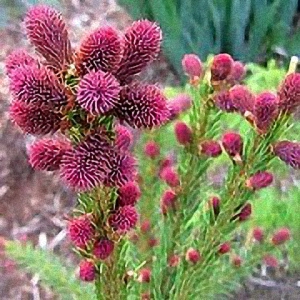The red tipped Norway spruce is a medium sized conifer that puts on a rather spectacular show for about two weeks in the spring. Like most other conifers, the spruce does not produce noticeable blooms but the new growth on its branches grows in bright red before changing to green.

Picea abies ‘Rubra Spicata’The tree is medium sized growing to a height of eight to twelve feet and a width of six to eight feet with the conical shape typical of spruce species.
This tree is an evergreen which prefers full sunlight but will tolerate partial shade. It is hardy in cold temperatures and grows well in most areas of the United States. The red tipped Norway spruce is recommended for zones 2 through 7 and requires some freezing temperatures in winter to thrive.
It is not recommended for areas where winter temperatures do not drop below 32 degrees Fahrenheit. The plant is an excellent addition to a shrubbery border and requires minimal care. Some pruning may be required to maintain its shape and to prevent it from growing too tall.
The botanical name of this spruce is Picea abies ‘Rubra Spicata’ and it grows at a slower rate than most other species of spruce. The original cultivar was found in Czechoslovakia in 1973 and introduced to England. It made its way to the United States in 1981 and quickly became popular with gardeners and landscapers.
The Picea abies ‘Rubra Spicata’ is relatively new to the United States and little specific information is available about pests and diseases. There are a number of fungi that attack spruce trees including Climacocysitis borealis and Polyporus caesius. Pests include budworm, which may kill seedlings and young trees, spruce beetles, white pine weevils, the spruce needle miner and the Cooley spruce gall aphid.
Read more: Discover Norway – Land of the midnight sun.
Like other varieties of Picea abies, the red tipped Norway spruce prefers an acidic to slightly alkaline soil. When planting young trees, gardeners and landscapers should take into account the tree’s eventual spread and space seedlings accordingly. Some gardeners reported that the red tips lasted less than two weeks, but had no other complaints about the tree.
Although a number of spruce trees are native to North America, the red tipped Norway spruce isn’t native to the U.S. and has little history in North America and England. There is a good deal of conflicting information from different sources about its size, shape and hardiness. Gardeners considering this tree should seek information from a reputable nursery or from their state university agricultural extension.




